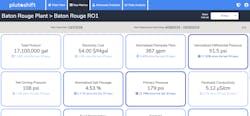Connecting Industrial Assets to Financial Metrics
To get the most out of industrial assets, manufacturers are starting to look beyond the maintenance of equipment and focus more on the financials. The ability to tie business metrics back to the plant is not a new concept. We’ve heard about real-time accounting models from Schneider Electric that were designed to connect the enterprise and the plant by providing visibility into the financial performance of industrial assets. It’s such a great concept that it was inevitable that other companies would follow suit.
Last week, two year old start-up Plutoshift, announced the availability of its own asset performance management (APM) platform. The cloud-based system—designed for food, beverage and chemical industries—uses artificial intelligence (AI) connected to multiple data streams, including supervisory control and data acqusition (SCADA), enterprise resource planning (ERP) and computerized maintenance management systems (CMMS). The result is process analysts and reliability managers receive actionable insights on the costs, risks and potential efficiencies of plant operations to help them achieve optimal performance.
The Plutoshift specifically designed its product to connect and analyze data to provide insights that let organizations better manage excess resource consumption—specifically, energy consumption.
“Energy consumption has a direct impact on financial metrics," said Plutoshift CEO and founder Prateek Joshi. “For most of the clients we work with, energy is expensive and they want to optimize that before anything else.The APM system includes an asset library with pre-built modules for things like cooling towers, CIP systems, clarifiers, dryers and more. Customers just pick the ones they want and we build a dashboard.”
According to the company, Plutoshift’s proprietary machine-learning algorithms leverage a plant’s existing historical and real-time data to visualize complex and dynamic relationships, extracting actionable insights between asset behavior and revenues.
“We use historical data to build a model of the plant to understand its behavior and, based on that, we can predict future behavior,” Joshi said.
To be clear, the technology is not performing a closed-loop action in which signals are sent back to the machine. Rather, it is an open loop concept that requires a human to take action. “It is not machine-centric; it is more business process finance-centric,” Joshi said. Yet, it is designed to be easy to use and understand with interactive, intuitive dashboards and alerts that are accessible from anywhere.
Joshi said the company has been working with customers in pilot projects that have resulted in about a 25 percent reduction in energy consumption, which ultimately eliminates wasteful spending for process industries that are expected to generate more revenues using less resources and without buying new assets.
“We built Plutoshift to give companies an easy way to bridge the relationship between their industrial data and financial performance to improve plant operations,” Joshi said. “AI is only as good as the business outcomes it supports, so our biggest priority is to make it as easy as possible for our customers to achieve their business goals and generate ROI as quickly as possible.”
About the Author
Stephanie Neil
Editor-in-Chief, OEM Magazine

Leaders relevant to this article:
